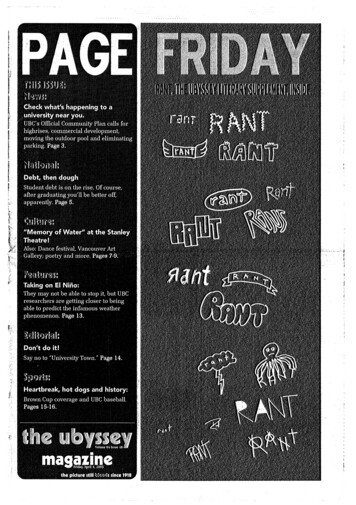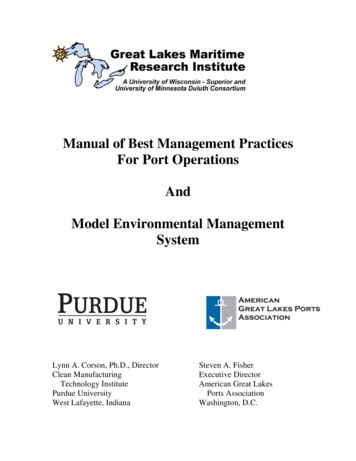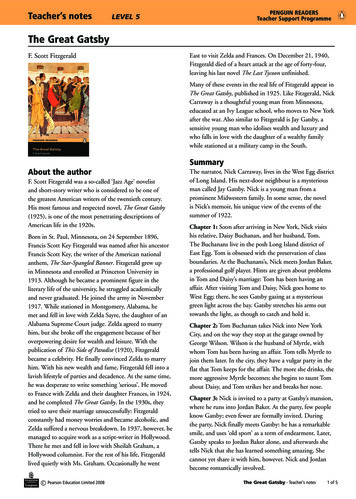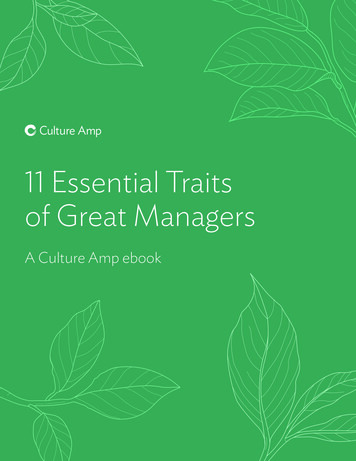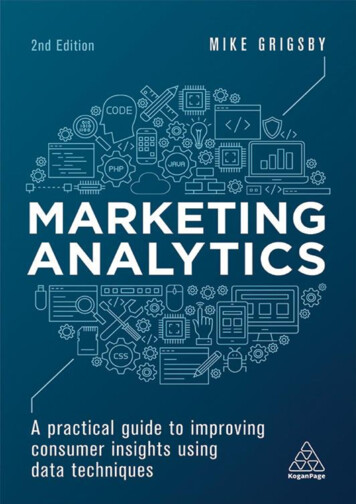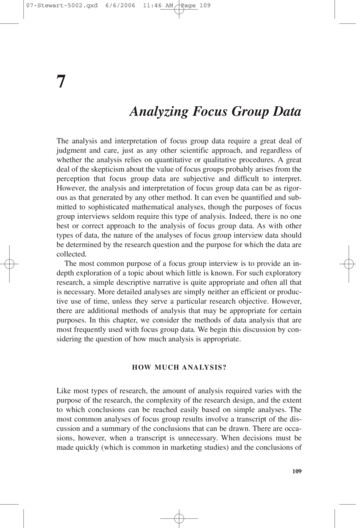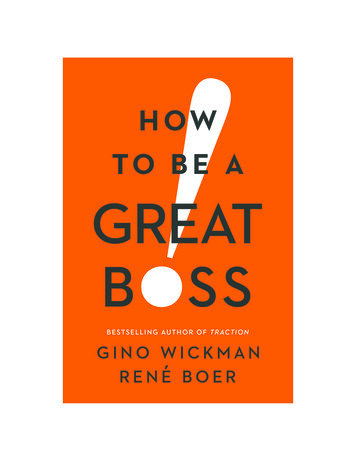
Transcription
This file is intended for promotional or review purposes only and shouldnot be sold, used for profit, or distributed to any non-media persons.Howto Be aGreatBoss5-Final-CompHowtoBeaGreatBoss.indd 17/11/16 2:37 PM
Other Books by Gino WickmanTractionDecide!Get a Grip, with Mike PatonRocket Fuel, with Mark C. Winters5-Final-CompHowtoBeaGreatBoss.indd 27/11/16 2:37 PM
Howto Be aGreatBossGino W ickmanand R ené BoerBenBella Books, Inc.Dallas, TX5-Final-CompHowtoBeaGreatBoss.indd 37/11/16 2:37 PM
Copyright 2016 by Gino Wickman and René BoerAll rights reserved. No part of this book may be used or reproduced in anymanner whatsoever without written permission except in the caseof brief quotations embodied in critical articles or reviews.The 8 Questions , Core Focus , 3-Year Picture , The Five LeadershipPractices , The Five Management Practices , The Meeting Pulse , The“Level 10” Meeting , The Issues Solving Track , LMA , The PeopleAnalyzer , GWC , Delegate and Elevate , The EOS Process , TheQuarterly Conversation , Clarity Break , The 5-5-5 ,The 90-Day World are trademarks of Gino Wickman.EOS and The Entrepreneurial Operating System are registered trademarks of Gino Wickman.All rights reserved.BenBella Books, Inc.10440 N. Central Expy., Suite 800 Dallas, TX 75231www.benbellabooks.com Send feedback to feedback@benbellabooks.comPrinted in the United States of America10 9 8 7 6 5 4 3 2 1Library of Congress Cataloging-in-Publication Datais available upon request.ISBN-13: 978-1-942952-84-8 e-ISBN: 978-1-942952-85-5Editing by Glenn YeffethCopyediting by James FraleighProofreading by Brittney Martinez and Cape Cod Compositors, Inc.Text design and composition by Silver Feather DesignGraphic design by Drew Robinson Spork DesignFront cover design by Emily Weigel, Faceout StudioJacket design by Sarah DombrowskyPrinted by Lake Book ManufacturingDistributed by Perseus Distribution www.perseusdistribution.comTo place orders through Perseus Distribution:Tel: (800) 343-4499 Fax: (800) 351-5073E-mail: orderentry@perseusbooks.comSpecial discounts for bulk sales (minimum of 25 copies) are available.Please contact Aida Herrera at ss.indd 47/11/16 2:37 PM
To my 135 clients. The 1,700 full-day sessionswe have done together were the provingground for every word in this book.—Gino WickmanTo my supportive, resilient, andwonderful wife, Judy. Thank you for alwaysbeing there for me. I love you very much.—René Boer5-Final-CompHowtoBeaGreatBoss.indd 57/11/16 2:37 PM
5-Final-CompHowtoBeaGreatBoss.indd 67/11/16 2:37 PM
contentsWhy the Word “Boss”?ixChapter 1Being a Great Boss1Chapter 2Do You Have What It Takes?9Chapter 3Delegate and Elevate 21Chapter 4Surrounding Yourself with Great People35Chapter 5Leadership, Managementand Accountability (LMA)53Chapter 6The Five Leadership Practices 59Chapter 7The Five Management Practices 79Chapter 8The Quarterly Conversation111Chapter 9The Four People Issues131Chapter 10A Final Word on People147Tools Summary155Additional Resources157Acknowledgments159About the Authors1635-Final-CompHowtoBeaGreatBoss.indd 77/11/16 2:37 PM
5-Final-CompHowtoBeaGreatBoss.indd 87/11/16 2:37 PM
W H Y T H E W O R D “ B OSS ” ?Consider this for a minute: no matter what title is on yourbusiness card, be it foreman, supervisor, manager, director,vice president, president, or chief executive officer, the people who report to you call you their boss.The word “boss” comes from the Dutch word “baas,”originally a term of respect used to address a person incharge. We use “boss” purposely because that is what youare—someone in charge, who leads and manages people. Ifyou are ever in doubt, please come back to this definition.We urge you to wear the title “boss” with pride. You’re incharge. Be in charge. Don’t be apologetic or tiptoe around it.Don’t give in to all the politically correct and watered-downtitles such as “team leader,” “coach,” or “people champion.”These terms certainly describe what a great boss is and does;they’re just not all-encompassing titles. Take pride in theresponsibility, but don’t become arrogant or take the title“boss” for granted.Never use the phrase “I’m the boss” in an overbearing orentitled manner. No one respects people like that. Instead,they whisper behind the backs of bosses who are so stuck onthemselves that they take their authority and oss.indd 97/11/16 2:37 PM
xh ow to b e a gr e at bossWalk through the offices or visit the production floors ofgreat companies and you’re likely to find engaged employees who are well led by great bosses. Those bosses create anenvironment where people show up every day because theywant to be there, not because they have to.So, if you’re a leader or manager of people and you aspireto be a great boss, this book is written for you. You need onlykeep an open mind and commit to becoming great. We’llprovide you with the tools to help you get there.5-Final-CompHowtoBeaGreatBoss.indd 107/11/16 2:37 PM
Ch a p t e r 1“If we treat people as they ought to be, we help thembecome what they are capable of becoming.”—GoetheWHAT IF EVERY DAY YOUR PEOPLE brought their“A game” to work? Do you believe that is even possible?In the next 154 pages we intend to show that it is possible, and we will teach you the tools that will transform howwell your people perform for you. You will discover how to: effectively delegate work and free yourself up totruly lead and manage,assess your team and surround yourself withGreat People,15-Final-CompHowtoBeaGreatBoss.indd 17/11/16 2:37 PM
2h ow to b e a gr e at boss apply five leadership practices and fivemanagement practices of all great bosses,communicate powerfully with each of youremployees, anddeal with employees that don’t meet yourexpectations.This book is different from any other leadership or management book you’ve ever read—and literally tens of thousands of them have been written. What makes it different isits practical application and immediate impact. It offers notheory. Instead, it offers a straightforward game plan to helpyou become a great leader and manager. We can say thatbecause every word and tool in this book have been testedand proven by thousands of leaders and managers whoseinfluence and results are undeniable.In the last twenty years we have personally worked withthe leadership teams of more than 180 companies and morethan 2,000 leaders and managers. In addition, our organization, EOS Worldwide, has 150 EOS Implementers aroundthe world who have taught these tools to another 2,500companies and more than 25,000 leaders and managers.Because we have tackled day-in, day-out problems with somany bosses, we know what works and what does not.Gino’s first book, Traction, which has sold hundreds ofthousands of copies, uncovered a vital need in the smallbusiness world: a need for a simple, real-world guide tohelp the leaders and managers of entrepreneurial companies become great bosses. That compelled us to write this5-Final-CompHowtoBeaGreatBoss.indd 27/11/16 2:37 PM
Being a Great Boss3book and provide that simple formula. Anyone with directreports who is seeking a practical, proven way to excel atwhat they do can follow these steps to bring out the best intheir people.This book is for you if: you are a leader, manager, or supervisor ofpeople in a privately held, 10- to 250-personentrepreneurial company; or you want to get the most out of your peopleand seek a simple, effective, and impactful wayto become a great boss.This book is also written to help the “not-so-goodbosses” get out of the way—to help them acknowledge thatthey lack the basic understanding, desire, and capacity todevelop the skills that will make them great.We have learned that to get the most from your people—to have a highly motivated workforce—you, in your role asboss, must create an environment where your people willthrive. Matthew Kelly, in his book Off Balance: GettingBeyond the Work-Life Balance Myth to Personal and Professional Satisfaction, points out that highly motivated employees enjoy both personal and professional satisfaction fromwhat they do. “They work hard . . . they enjoy the people theywork with; they feel respected by their boss; they feel theirwork is making a contribution to customers’ lives; they findthe challenge of their work matches their abilities; and theyknow why they go to work each day.”5-Final-CompHowtoBeaGreatBoss.indd 37/11/16 2:37 PM
4h ow to b e a gr e at bossThis may be apparent to you already, but what is surprising is this: Kelly, in his efforts to find a link between“work-life balance” and a highly engaged workforce, interviewed well-respected people at dozens of the world’s bestcompanies. He asked these companies if he could interview people who they thought best exemplified work-lifebalance. What he discovered after interviewing these people was that they actually worked an average of nine hoursmore per week than their counterparts did. They valuedjob satisfaction over work-life balance. So, when you focusyour efforts to improve your people’s satisfaction level withtheir jobs, versus the number of hours they work, think ofthe upside.Here’s something else we’ve learned after we surveyedour clients at EOS Worldwide. When asked why theyengaged us, 82.4 percent reported they were not gettingenough out of their people; they weren’t on the same page,working together to win. In fact, “people issues” are oneof the most common frustrations shared by bosses—notsales, not profit . . . people! However, keep this in mind: asfrustrated as you might be with your people, the fact is, they areyour number one competitive advantage.Think about that for a minute. You may hold patents,own proprietary technology, and have tremendous brandawareness, but in the end, it all boils down to people. So,for better or worse, the people you employ or who reportdirectly to you are your only real differentiator.Competitors can steal your ideas and copy your products. After all, they essentially do what you do. They can5-Final-CompHowtoBeaGreatBoss.indd 47/11/16 2:37 PM
Being a Great Boss5even steal your playbook—how you do what you do. But itdoesn’t matter because in the end, being a great boss comesdown to execution—doing what you do better than thecompetition. Here is a great example. During the 1960s,opponents of the Green Bay Packers, who won two SuperBowls and five NFL Championships during that decade,had seen Vince Lombardi’s famous “Power Sweep” so manytimes that they not only knew the play inside and out, theyalso knew when it was coming. But they still couldn’t stopit. Lombardi was that good at leading his players to becomethat good at running that play.The advantage of being a boss like Lombardi is that youhave the opportunity to surround yourself with people whoyou want to work with and who want to succeed. You havethe responsibility to hire them and fire them. If you’re notsatisfied with the performance of the people reporting toyou, you have to accept the responsibility of doing something about it. However, before you fire anyone, you mustask yourself, “Have I done everything possible to makethem successful? Have I failed them in any way?” Make sureyou’ve done your part.As we’ve mentioned, the tools we teach in this book aresimple; they have to be, because the journey to become a greatboss is not easy. People often confuse “simple” and “easy.” Thedefinition of “simple” is not elaborate, not complicated, easy tounderstand. The definition of “easy” is not hard or difficult;requiring no great effort; free from pain, discomfort or care.The tools and exercises that comprise this “how to” guidehave been honed while working hands-on with thousands5-Final-CompHowtoBeaGreatBoss.indd 57/11/16 2:37 PM
6h ow to b e a gr e at bossof bosses. In each chapter we share stories from every typeof boss—owners, leadership team members, managers, andsupervisors—to show you that these tools truly work forbosses at any level. They will help you lead, manage, andretain the sort of employees we call Great People. And themore Great People you surround yourself with, the moreGreat People you will attract to your organization. TheseGreat People will free you from the day-to-day grind thathas kept you from getting the most from your business andliving a more fulfilling life. If we’ve piqued your interest,read on.State of the American WorkforceSince 2000, the Gallup Organization has been conductingan annual survey of American workers. The results haven’tchanged much year to year and reveal that only 31.5 percentof full-time American workers are “engaged” at their jobs.These employees show up early, leave late, come up withcreative solutions, attract and retain customers, and bringenergy to the workplace. Jim Clifton, Gallup’s CEO, assertsthat this group more than likely works for a great boss.However, Gallup reports that 17.5 percent of Americanworkers are “actively disengaged” at work. This group likelyworks for a boss that makes them miserable, and as a result,they spread their discontent throughout the organization.These employees are more likely to steal from their employer,miss days at work, and drive customers away.5-Final-CompHowtoBeaGreatBoss.indd 67/11/16 2:37 PM
Being a Great Boss7Sadly, the survey shows that the remaining 51 percent ofAmerican workers are “not engaged” at work! These employees meet the minimum requirements, but they don’t viewtheir jobs as a major component of their daily lives. They’reflying just under the radar while collecting their paycheck.It’s been estimated that their lost productivity costs Americanbusinesses a staggering 500 billion annually.Clifton goes on to state that the single most importantdecision that business owners make is deciding whom tohire or promote to management positions. Choosing theright people propels their companies forward, while thewrong people hold them back. Additionally, a 2015 HarrisPoll revealed that 39 percent of employees have no idea oftheir company’s goals and objectives, 47 percent are unfamiliar with the state of their company’s performance, and44 percent don’t understand how the role they play helps theorganization meet its goals.Think about the implications for your organization.Gallup suggests that only a third of your employees areactually driving your results. If everyone were activelyengaged at work, what results could you achieve?Whether your results are better or worse than thoserevealed by these polls, you can see that significant opportunity may well exist in your organization. Are you willing to take responsibility for all the issues that have causedemployees to disengage? For example, if you are constantlyfrustrated with people who don’t meet your expectations, butyou don’t explain your expectations, you may be part of theproblem. Acknowledging and taking responsibility for poor5-Final-CompHowtoBeaGreatBoss.indd 77/11/16 2:37 PM
8h ow to b e a gr e at bossemployee performance and engagement is the first step. Poorbosses don’t grasp this and will blame factors “beyond theircontrol.” Great bosses will rise to the challenge. Which bossare you?We’re facing a crisis that is not just measured by a lackof opportunity for the workforce, but also by the lack ofenthusiasm that the workforce has for their jobs. We’re losing our competitive advantage. You cannot expect to meetyour goals with half your team sitting on the bench—and17.5 percent actually heckling you. You need an engaged,raring-to-go workforce. Your choices are to lead, follow, orget out of the way. You must decide. And remember, choosing not to be a great boss is okay. Just get out of the way andbe willing to follow.So, do your people truly matter to you? Do you viewthem as your number one competitive advantage? Are youexcited about building a team of highly motivated employees and getting the most from them? If so, then get ready toanswer the question that starts the next chapter.5-Final-CompHowtoBeaGreatBoss.indd 87/11/16 2:37 PM
Other Books by Gino Wickman Traction Decide! Get a Grip, with Mike Paton Rocket Fuel, with Mark C. Win

